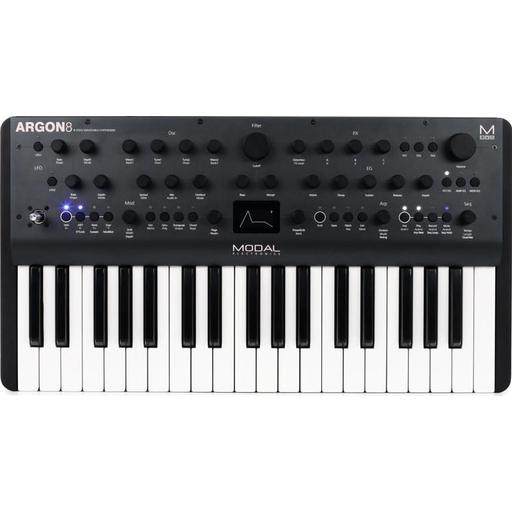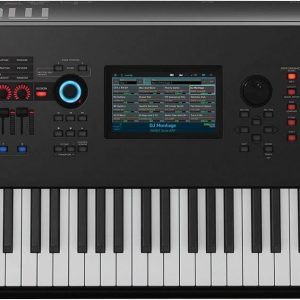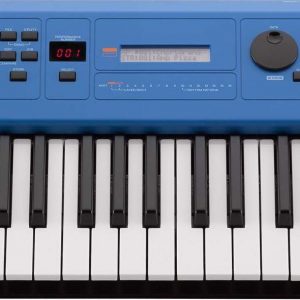Modal Electronics Argon8
$465.99
Experience the power of modern synthesis with the Modal Electronics Argon8, a cutting-edge 8-voice polyphonic synthesizer.
Compare
Description
The Modal Electronics Argon8 synthesizer is a powerful and versatile instrument that comes packed with features that cater to a wide range of musical styles and production needs. It is designed to deliver high-quality sound, impressive performance capabilities, and an easy-to-use interface that allows users to focus on creating music, rather than getting bogged down in technicalities.
The synth’s sound engine is built around a set of 120 wavetables that cover a wide range of textures, tones, and sonic characteristics. Users can manipulate these wavetables using a range of synthesis techniques, including subtractive, FM, ring modulation, and waveshaping. This level of flexibility allows users to create complex and interesting sounds that can be used across a range of genres, from EDM and techno to ambient and experimental music.
At the core of the Argon8’s sound engine is an OSC core that is capable of delivering up to 32 oscillators per voice, which means that it can produce thick and rich sounds that are perfect for creating dynamic and immersive soundscapes. These oscillators can be modulated using a range of LFOs, envelopes, and other modulation sources, allowing users to create evolving and dynamic sounds that are steeped in movement and texture.
The synth’s interface has been designed to be intuitive and easy to use, with a large LCD screen that provides a clear overview of all the settings and functions. The screen is complemented by a range of hardware controls, including knobs, buttons, and a joystick, which give users quick access to all the key parameters and functions. This hands-on approach to sound design allows users to explore the instrument’s capabilities in real-time, and to create interesting sounds on the fly.
Another standout feature of the Argon8 is its powerful onboard sequencer, which can be used to create complex and evolving patterns that can be synced to an external MIDI clock or DAW. The sequencer can be used to create polyphonic and monophonic sequences, and can also be used to trigger external devices, making it a great tool for live performance and studio production.
Overall, there’s a lot to love about the Modal Electronics Argon8 synthesizer. It’s a powerful and versatile instrument that delivers high-quality sound, impressive performance capabilities, and an easy-to-use interface that allows users to focus on creating music, rather than getting bogged down in technicalities. Whether you’re a seasoned synth expert or a beginner just starting out, the Argon8 is an excellent choice that is sure to inspire and excite.
Modal Electronics Argon8 properties
| Product name |
Modal Electronics Argon8 |
| Brand |
Modal Electronics |
| Type |
Synthesizers |
| Keys |
Yes |
| Number of Keys |
37 pcs |
| Pre-Programmed Effects |
Yes |
| Connections |
3.5mm (AUX), Headphone, Keyboard Pedal, MIDI, USB |
| Colour |
Black |
| Power Supply |
Electrical Cable to Wall Socket |
Frequently Asked Questions:
What are the main differences between the Modal Electronics Argon8 and its predecessor, the Zero8?
The Modal Electronics Argon8 and Zero8 share several similarities as they both belong to the same product line. However, there are also some key differences between them:
1. Voices: The Argon8 offers 8 voices (layers), while the Zero8 had only 4 voices. This means that the Argon8 can play up to eight sounds simultaneously, making it more suitable for complex textures and multilayered performances.
2. Polyphony: The Argon8 boasts a whopping 16-voice polyphony compared to its predecessor's 4-voice polyphony. This allows for richer, fuller chords and more realistic piano sounds.
3. Oscillator types: Both synthesizers have six oscillators per voice, but the Argon8 offers a wider range of oscillator types including Sawtooth, Pulse Width Modulated (PWM) Square, Triangle, Noise, and Sub-Oscillator. The Zero8 had fewer oscillator types available.
4. Filter types: The Argon8 includes six filter types for each voice, including Low Pass, High Pass, Band Pass, Notch, Comb, and Phaser. The Zero8 only had two filter types (Low Pass and High Pass) per voice.
5. Modulation Matrix: The Argon8 has a more sophisticated modulation matrix that allows for greater flexibility in routing modulators and destinations. This results in richer and more complex sound sculpting capabilities compared to the Zero8's simpler modulation scheme.
6. Effects: Both synthesizers have built-in effects such as reverb, chorus, delay, compression, and EQ. However, the Argon8 has more extensive effect options including a stereo delay/echo, an additional high-pass filter for the reverb, and a distortion effect that was not available in the Zero8.
7. Sequencer: The Argon8 has an improved sequencer with up to 256 steps per sequence and 128 patterns. It also includes features like swing, randomization, and the ability to transpose sequences on-the-fly. In contrast, the Zero8's sequencer was more basic, offering only up to 32 steps per sequence and without some of these advanced features.
Overall, the Argon8 is a significant upgrade from the Zero8, providing more voices, polyphony, oscillator types, filter types, modulation options, effects, and an improved sequencer. These enhancements make it a versatile instrument for creating complex textures, experimental sounds, and intricate performances.
What unique features does the Modal Electronics Argon8 synthesizer offer beyond traditional subtractive synthesis?
The Modal Electronics Argon8 synthesizer goes beyond traditional subtractive synthesis with its advanced wavetable oscillators, which feature a wide range of classic and modern waveforms, as well as the ability to morph between them. Additionally, it offers an extensive modulation matrix with 64 sources and sinks, allowing for complex and expressive sound design. The Argon8 also features a unique "Mutator" section that allows for real-time manipulation of sound parameters, adding even more sonic possibilities. Overall, the Argon8 offers a powerful and flexible synthesis engine that combines traditional techniques with innovative features.
"How can I effectively utilize the advanced sequencing capabilities of the Modal Electronics Argon8 synthesizer to create intricate and complex rhythms and melodic patterns?"
To effectively utilize the advanced sequencing capabilities of the Modal Electronics Argon8 synthesizer to create intricate and complex rhythms and melodic patterns, follow these steps:
1. Familiarize yourself with the Argon8's sequencer feature by reading through the user manual or watching online tutorials. Load a preset or create a new patch with the desired sound. Access the sequencer by pressing the SEQ button on the Argon8's front panel. Use the UP and DOWN arrows to select the track you want to sequence (either MIDI notes, envelopes or LFOs). Press the REC button to enter recording mode. Play the desired rhythm or melody on an external MIDI controller or directly from the Argon8's keyboard. To record multiple takes, press the MERGE button and repeat step 6. Use the SHIFT + UP/DOWN arrows to select the take you want to use. Use the VARIATION knob to introduce randomness into the sequence by modifying certain parameters or introducing variation in the notes played. Use the AUTO mode to have the sequencer generate rhythms and patterns automatically. Utilize the swing feature to add a groove element to your sequences. Experiment with different sequence lengths (1-64 steps) and note durations (1-32nd notes) to create complex patterns. Use the MUTE function to silence individual tracks or groups of tracks, allowing you to create more intricate rhythms. Utilize the FX section to add further processing to your sequences, including delays, reverbs and other modulation effects. Save your sequence by pressing the STORE button and selecting a free location in the preset bank or user bank. By following these steps, you'll be able to create intricate and complex rhythms and melodic patterns using the advanced sequencing capabilities of the Modal Electronics Argon8 synthesizer. Remember to experiment with different techniques and settings to find what works best for your specific musical needs.
What is the optimal parameter setting for the Arpeggiator on the Modal Electronics Argon8 to achieve a smooth and stutter-free arpeggio pattern when using a complex chord voicing?
The first step is to choose the right mode of operation for your Arpeggiator. For creating smooth arpeggios, especially with complex chords, I recommend using the "Random" or "Step" mode. These modes allow for a more gradual and controlled transition between notes, reducing the likelihood of stuttering. Setting the Rate**: The rate at which the arpeggio pattern plays back is crucial. A higher rate can lead to stuttering if the pattern doesn't have enough space to breathe. For complex chords, it's often better to start with a lower rate and adjust as needed. This allows you to feel out how the notes interact with each other before increasing the speed. Selecting the Gate**: The gate setting controls when the arpeggio starts playing back. A shorter gate time can lead to stuttering if the pattern changes too quickly. For complex chords, a longer gate time might be necessary to allow for smoother transitions. Setting the Note Delay**: This feature allows you to adjust the timing of each note in relation to the others. By delaying certain notes, you can create more space and reduce the likelihood of stuttering. Choosing the Pattern Size**: The pattern size determines how many steps are included in your arpeggio pattern. A larger pattern size can lead to more complex patterns but also increases the risk of stuttering. For complex chords, starting with a smaller pattern size might be beneficial and then adjusting as needed. Adjusting the Swing**: This feature allows you to adjust the rhythm of each note in your pattern. By adding some swing or shuffle to your arpeggio, you can create a more natural feel that's less prone to stuttering. Experimentation and Fine-Tuning**: The final step is all about experimentation and fine-tuning. Once you've set up your Arpeggiator with the optimal parameters, experiment with different settings and adjust as needed to achieve the desired sound.
Before you buy Modal Electronics Argon8








Reviews
There are no reviews yet.